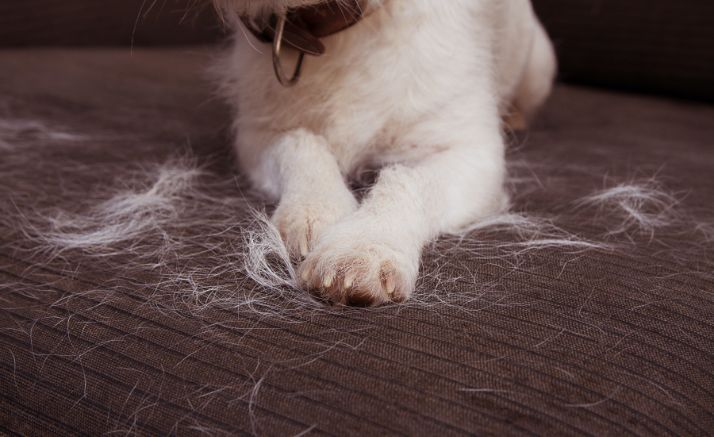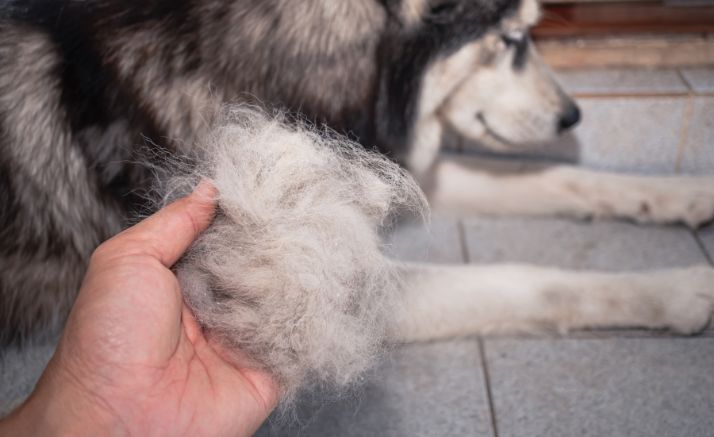Every pet parent knows the struggle: you vacuum, sweep, and brush, but somehow, there’s still dog hair everywhere! Dealing with dog shedding can feel like a never-ending battle, but fear not! With the right approach, you can minimize shedding and keep your home looking and feeling clean. In this guide, we’ll explore why dogs shed, how to reduce shedding, and practical tips to keep your furry friend’s coat under control.
Understanding Why Dogs Shed:
Dog shedding is a common concern for pet owners, but it’s essential to understand the reasons behind this natural process to effectively tackle it and implement strategies on how to reduce dog shedding.
Regulating Body Temperature:
Dog shedding plays a vital role in helping dogs regulate their body temperature. In warmer months, dogs shed their thick winter coat to stay cool, while in colder months, they grow denser coats for warmth. Understanding this seasonal shedding pattern can guide pet owners in managing dog shedding effectively.
Removing Old or Damaged Fur:
Shedding also serves the purpose of removing old or damaged fur from a dog’s coat. This process allows for the growth of new, healthy fur, promoting overall coat health. By facilitating the shedding of old fur, pet owners can help prevent matting and tangling, which can lead to discomfort for their furry companions.
Maintaining Skin Health:
Dog shedding is essential for maintaining skin health. It helps remove dead skin cells and promotes air circulation, reducing the risk of skin issues such as irritation and infections. Understanding the role of shedding in skin health emphasizes the importance of regular grooming and care to support a healthy coat and skin.
Tips to Reduce Dog Shedding:
Reducing dog shedding requires a combination of proactive measures and consistent care to manage your furry friend’s coat effectively. Here are some practical tips on how to reduce dog shedding and keep your home fur-free:
Regular Grooming Sessions: One of the most effective ways to minimize dog shedding is by establishing a regular grooming routine. Brushing your dog’s coat daily or several times a week helps remove loose fur, preventing it from accumulating around your home. Use a de-shedding tool or slicker brush specifically designed to tackle dog shedding and promote a healthy coat.
Nutritious Diet: A balanced and nutritious diet plays a crucial role in maintaining your dog’s overall health, including their skin and coat condition. Choose high-quality dog food that is rich in essential nutrients such as omega-3 fatty acids and vitamins, which support healthy skin and reduce dog shedding. Consult with your veterinarian for dietary recommendations tailored to your dog’s specific needs.
Hydration: Adequate hydration is essential for promoting healthy skin and reducing dog shedding. Make sure your furry friend has access to fresh, clean water at all times, especially during warmer months or after physical activity. Proper hydration helps maintain skin elasticity and reduces dryness, which can contribute to excessive shedding.
Regular Baths: Bathing your dog regularly with a gentle, dog-friendly shampoo helps remove dirt, dander, and loose fur, minimizing shedding and keeping their coat clean and healthy. However, be cautious not to over-bathe your dog, as excessive bathing can strip their skin of natural oils, leading to dryness and increased shedding. Aim for bathing your dog every 4-6 weeks or as needed, depending on their breed and activity level.
Controlled Environment: Create a clean and allergen-free environment in your home to reduce dog shedding. Vacuum and dust your home frequently, paying particular attention to areas where your dog spends the most time. Wash your dog’s bedding regularly to remove accumulated fur and dander, and consider using air purifiers to minimize airborne allergens that can exacerbate shedding.
Regular Veterinary Check-ups: Schedule regular check-ups with your veterinarian to monitor your dog’s overall health and address any underlying medical conditions that may contribute to excessive shedding. Your vet can guide how to stop dog shedding and recommend appropriate treatments or supplements to support your dog’s coat health.
Benefits of Managing Dog Shedding:
Dog shedding is a natural process that all dog owners must contend with, but managing it effectively offers numerous benefits for both you and your furry companion. From maintaining a clean home to promoting your pet’s overall health and well-being, here are the key benefits of managing shedding:
A Cleaner Home Environment:
One of the most immediate benefits of managing shedding is a cleaner home environment. Regular grooming and cleaning practices help remove loose fur from your pet’s coat before it can accumulate on furniture, floors, and clothing. By staying on top of shedding, you can minimize the need for constant vacuuming and dusting, leaving your home feeling fresh and tidy.
Reduced Allergen Exposure:
Shedding not only contributes to dust and debris in your home but can also exacerbate allergies for sensitive individuals. Managing shedding helps reduce the amount of pet dander and allergens present in your home, providing relief for allergy sufferers and creating a healthier indoor environment for everyone.
Improved Coat Health:
Regular grooming and maintenance play a crucial role in promoting your pet’s coat health. By removing loose fur and tangles, you can prevent matting and tangling, which can lead to discomfort and skin irritation for your furry friend. Additionally, proper grooming stimulates oil production in the skin, leading to a shinier, healthier coat overall.
Enhanced Bonding Experience:
Grooming sessions offer valuable opportunities for bonding and interaction between you and your pet. Spending time grooming your furry companion not only helps maintain their physical health but also strengthens the emotional bond between you. These moments of connection can enrich your relationship with your pet and foster a sense of trust and companionship.
Early Detection of Health Issues:
Regular grooming sessions provide an opportunity to inspect your pet’s skin and coat for any signs of abnormalities or health issues. By closely examining your pet’s coat, you may detect early warning signs of skin infections, parasites, or other health concerns that require veterinary attention. Early intervention can lead to timely treatment and improved outcomes for your pet’s health.
Stress Reduction for Your Pet:
Proper grooming and coat maintenance can help reduce stress and discomfort for your pet. Removing loose fur and tangles prevents matting, which can pull on the skin and cause discomfort. Additionally, grooming sessions provide opportunities for relaxation and pampering, helping your pet feel calm and content in your care.
Minimized Risk of Overheating:
In warmer months, managing shedding is especially important for preventing overheating in your pet. By removing excess fur, you allow for better air circulation and heat dissipation, helping your pet stay cool and comfortable in hot weather. This is particularly crucial for breeds with thick or double coats that are prone to overheating.
Conclusion:
Dealing with dog shedding may seem like a daunting task, but with patience and consistency, you can keep shedding under control and enjoy a clean and fur-free home. By understanding why dogs shed, implementing a regular grooming routine, and addressing any underlying health issues, you can minimize shedding and keep your canine companion looking and feeling their best. Remember, a little extra fur is a small price to pay for the unconditional love and joy that our furry friends bring into our lives!










